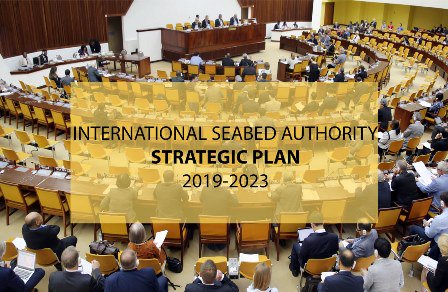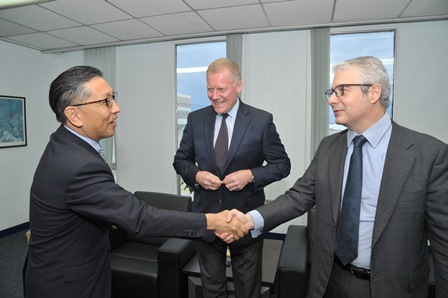Pradeep A. Singh
Pradeep Singh is a research associate at the Institute for Advanced Sustainability Studies (Potsdam, Germany).
Due to the ongoing COVID-19 pandemic, the scheduled July 2020 session of the Legal and Technical Commission, the Council and the Assembly of the International Seabed Authority (ISA) could not take place in-person in Kingston, Jamaica. While meetings of the Legal and Technical Commission carried on in a virtual format, it was initially decided that the 26th Session of the ISA would be postponed to October 2020 and conducted in a reduced format.
Not long after, it became clear that an in-person meeting in October would also not be possible, resulting in a tentative postponement to early December. Nevertheless, it was thought to be necessary to get the wheels moving already in September. With that in mind, the Acting President of the Council issued a letter proposing the early resumption of the 26th Session of the ISA to enable the Council “to take certain decisions of a procedural nature that are usually addressed without a debate” via the use of the “silence procedure”. The justification for the use of this procedure was to give “priority to the most urgent and time-sensitive items on the agenda of the session requiring decisions before the end of the year”. Shortly after that, the President of the Assembly (25th Session) issued a letter proposing a similar arrangement for the Assembly.
As noted in both letters, these special arrangements were to be used sparingly and only for procedural and organizational matters. Inspiration for the use of the silence procedure at the ISA was drawn from the practice adopted at the thirtieth Meeting of State Parties to the United Nations Convention on the Law of the Sea for taking decisions. Other international bodies such as the UN General Assembly and the UN Economic and Social Council, among others, initially adopted the procedure earlier on. Essentially, the silence procedure is a ‘tacit acceptance’ procedure, whereby a draft decision of a text will be considered as having been agreed upon unless an express objection is raised.
Under the silence procedure adopted at the ISA, the President of the Council or the Assembly will issue a letter with a draft decision and circulate it to the Member States of the Council or the Assembly, as the case may be, with a period of at least 72 hours to object. Simultaneously, the said letter is also expected to be uploaded on the ISA website. In the event a State delegation wishes to object to the draft decision, a letter or note verbale must be submitted within the said period. If no State delegation “breaks the silence”, the draft decision is considered as adopted. If a proper and timely objection is lodged, the draft decision will not be adopted and the President of the respective organ would have to enter into consultations with the relevant groups to address the concerns and subsequently issue another amended draft decision for further reconsideration.
It is necessary to emphasize here again that the silence procedure is only intended to be used under extraordinary circumstances involving decisions that are of a procedural nature or of great urgency since the work of the ISA is expected to be conducted in the full sight of the public. The silence procedure provides very limited scope for debate or exchange of views that typically occur at open meetings of the Council and the Assembly. Observer members, an integral component at the ISA, play an essential role in these open meetings; however, their ability to inform discussions and influence outcomes are effectively subdued under the silence procedure.
While some of the matters that were considered under the silence procedure were appropriate, such as the appointment of the Presidents of the respective organs, some other matters were arguably ambiguous or inappropriate. For example, it was unclear how the process for the election of the Secretary-General would have taken place had there been two or more candidates that were nominated, bearing in mind that a procedure for voting would have been necessary for that instance. The possibility of this happening should have been recognized and clarified at the outset. Likewise, discussions on the proposed budget of the ISA for 2021-22 at the Council should have also been opened up to all member States and observers of the ISA to solicit the broader concerns of all parties to enable a full and effective exchange of views. Coincidentally, a group of States recently broke the silence on this matter and a reduced budget is now under consideration.
Finally, the recent use of the silence procedure at the Council to consider and approve the application for a plan of work for exploration of polymetallic nodules was arguably inappropriate. This matter was clearly not a procedural matter and did not seem to be an urgent or time-sensitive matter. As such, the matter should have been deferred to the next in-person, open meeting of the Council, in order to allow for the matter to be thoroughly debated before a decision is made. This not only ensures transparency but also allows for oversight over the work of the Council. Although the President of the Council subsequently issued a letter on 27 November to allow for an exchange of views to take place through the submission of written statements, this letter was only uploaded on the website of the ISA well after the period for submission of statements had expired. No explanations were given for this delay and it now appears on the ISA website as though it was duly and promptly uploaded. Fortunately, several ISA Observer members such as the Institute for Advanced Sustainability Studies, the Deep Sea Conservation Coalition, the Pew Charitable Trusts and Greenpeace International had managed to provide statements despite that fiasco. Nevertheless, it very much remains a possibility that other member States (non-Council members) and Observers were deprived of the opportunity to submit statements and bring their concerns to the attention of the Council members. Had it been at an in-person meeting of the Council, all non-Council member States and Observer members in attendance would have had the opportunity to make oral interventions.
Moving forward, it is hoped that this incident of the President of the Council’s letter not being circulated to non-Council member States and observer members of the ISA or duly uploaded on the website of the ISA at the very least will be investigated in order to ensure that it does not repeat in future. Furthermore, given that the possibility of conducting in-person meetings in 2021 (for example, the meeting of the Council in February/March) remains in doubt, it is likely that the silence procedure would also be relied upon for all or some part of next year. In this respect, it would be necessary to ensure the proper and extremely sparing utilization of the silence procedure at the ISA, and in particular, to prevent its inappropriate use (or plain abuse) to fast track decision-making and other related processes at the ISA.





